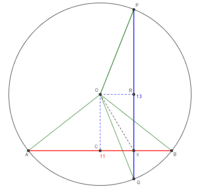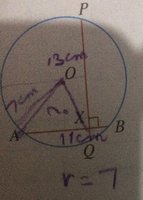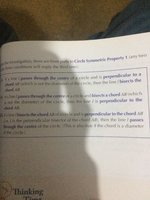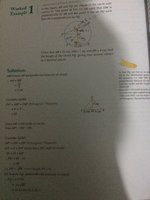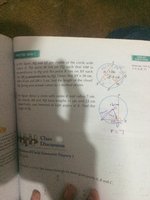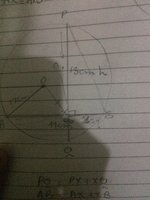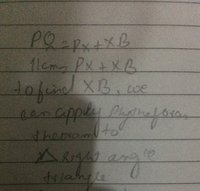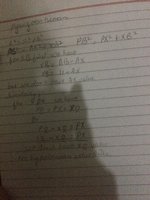Circle theorem problem
- Thread starter Mehndi
- Start date
- Joined
- Apr 12, 2005
- Messages
- 11,339
Untrue!!! Simply labeling and thinking constitutes EXACTLY how to start. You no longer need to think that.
There is always a potentially very tedious solution based on the Pythagorean Theorem. It can be a lot of algebra.
On the other hand, perhaps you are studying a particular section of your textbook which has given you a specific theorem or two that might simplify things? For example, do you know that: mAngle AXP = ½(mArc AP + mArc QB)? (m = "The Measure Of")
There is always a potentially very tedious solution based on the Pythagorean Theorem. It can be a lot of algebra.
On the other hand, perhaps you are studying a particular section of your textbook which has given you a specific theorem or two that might simplify things? For example, do you know that: mAngle AXP = ½(mArc AP + mArc QB)? (m = "The Measure Of")
No sir.
I am studying symmetric propriety of circle .the first explanation is attached.i am sending work example 1 and the explanation for it.sir I did practice q1 well but q2 it is not my cup of cake.if convenient plz send solution I will check out where did I made mistake on my own. I will be very grateful to u for this effort
I am studying symmetric propriety of circle .the first explanation is attached.i am sending work example 1 and the explanation for it.sir I did practice q1 well but q2 it is not my cup of cake.if convenient plz send solution I will check out where did I made mistake on my own. I will be very grateful to u for this effort
Attachments
Steven G
Elite Member
- Joined
- Dec 30, 2014
- Messages
- 14,598
Please stop asking us to solve your problem. We just do not do that on this forum. We expect you to solve this problem with our help.
You can label some more sides. You should see that 13 = PQ = PX + XQ and that 11 = AB = AX + XB. Using variables which you will define label does two sided. See if anything comes to mind. You have a right angle, how can that be helpful?
You can label some more sides. You should see that 13 = PQ = PX + XQ and that 11 = AB = AX + XB. Using variables which you will define label does two sided. See if anything comes to mind. You have a right angle, how can that be helpful?
Sorry for inconvenience sir.it was my first day at the forum and I didn’t read rules.plz have a look at some of my progress .i know for right angle triangle we can apply Pythagoras theoram but it doesn’t have certain values needed for it. As u can see below
Attachments
Dr.Peterson
Elite Member
- Joined
- Nov 12, 2017
- Messages
- 16,762
I am studying symmetric propriety of circle .the first explanation is attached.i am sending work example 1 and the explanation for it.sir I did practice q1 well but q2 it is not my cup of cake.
I would draw in the perpendicular bisectors of the chords (which are the subject of the first page you show), as well as OX, and start labeling things. You should notice a right triangle (in fact, a rectangle) that will take you right to the goal.
pka
Elite Member
- Joined
- Jan 29, 2005
- Messages
- 11,995
That is wrong. The line segment OQ is a radial segment as such has length 7.Sir the answer at back of book for OQ value is 5.05
If Y is the midpoint of AB then the length of OY is 18.75
Dr.Peterson
Elite Member
- Joined
- Nov 12, 2017
- Messages
- 16,762
You meant OX = 5.05 (approximately), and that is correct. It's actually [MATH]\sqrt{25.5}[/MATH].Sir the answer at back of book for OQ value is 5.05
Please show your work, especially your answer, so we can tell you where you are wrong. Surely you had to use PQ in some way.Sir did it as you said by drawing a chord.question was sort of solved.but I did not use the the value of PQ provided.is it right.will it not affect my result.plz check if am doing well
Here is the drawing:
